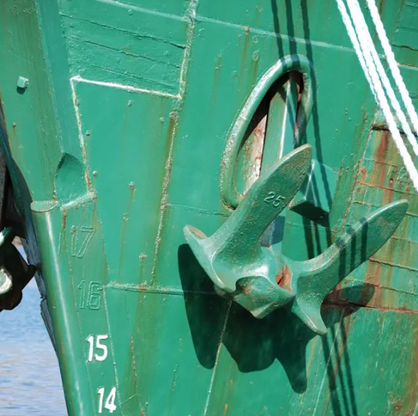4.1 Ship Anchors
Completion requirements
Ship Anchors
This chapter looks at the different types of anchors used on merchant vessels and the crucial factors influencing their selection.
Types of Anchors for Merchant Ships
While various anchor designs exist, a select few dominate the world of merchant shipping due to their efficiency and reliability. The most common types are :
- High-Holding Power (HHP) Anchors: HHP anchors are the most common types for merchant vessels. They feature a balanced design, a fluked shank and a crown that ensure proper orientation and deep penetration into the seabed. Popular HHP anchor variations include AC or Navy anchors, LOFAN anchors, and SAC anchors.

- High Efficiency (HE) Anchors: These anchors are a recent development, offering exceptional holding power in specific seabed conditions at a lighter weight compared to traditional HHP anchors. However, their specialized design might not be suitable for all anchoring scenarios encountered by merchant ships.
- Danforth Anchors: Though not as prevalent on large merchant vessels, Danforth anchors are sometimes used on smaller support vessels or barges. Their lightweight, simple design with two flukes makes them effective in soft seabed conditions like mud or sand.
Factors Influencing Anchor Selection
Choosing the right anchor for a merchant vessel is paramount for safe and secure anchoring. Several factors come into play during this critical decision:
- Vessel Size and Displacement: The size and weight of the vessel directly influence the required holding power of the anchor. Larger ships naturally require more robust anchors with a higher holding capacity to withstand wind, waves, and currents.
- Seabed Conditions: The type of seabed where a ship is likely to anchor significantly impacts anchor selection. HHP anchors excel in various seabed types like sand, clay, and mud. However, for rocky seabeds, special anchor designs with reinforced flukes might be necessary.
- Operational Needs: The typical anchoring scenarios a vessel encounters can also influence anchor choice. If frequent anchoring in adverse weather conditions is expected, a high-holding power anchor offering maximum security is essential.
- Storage and Handling Considerations: The size and weight of the anchor must be factored in for onboard storage within the chain locker and handling by the windlass.
- Regulations and Certifications: International maritime regulations play a role in anchor selection. The chosen anchor design must comply with the relevant standards established by classification societies like Lloyd's Register or American Bureau of Shipping (ABS).
Last modified: Thursday, 17 October 2024, 12:46 PM